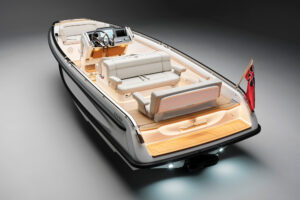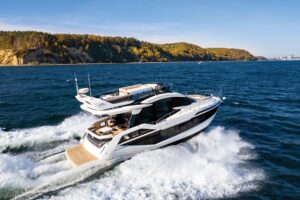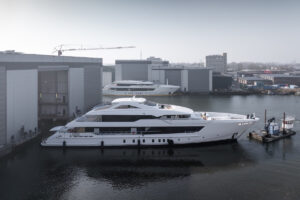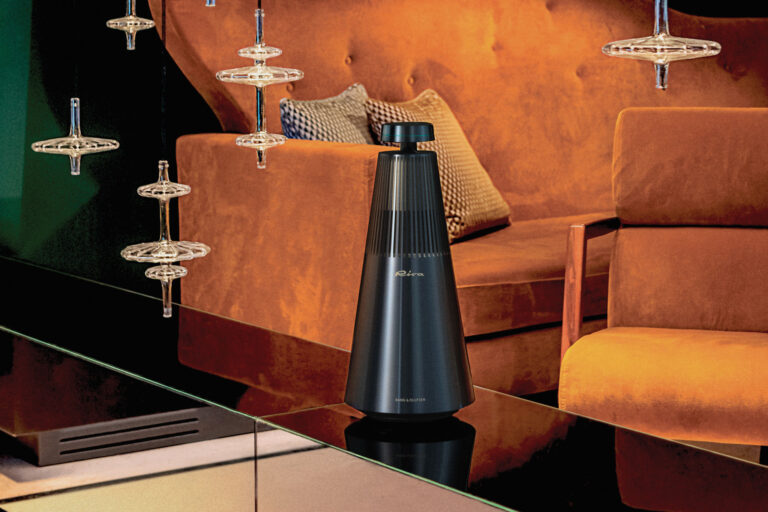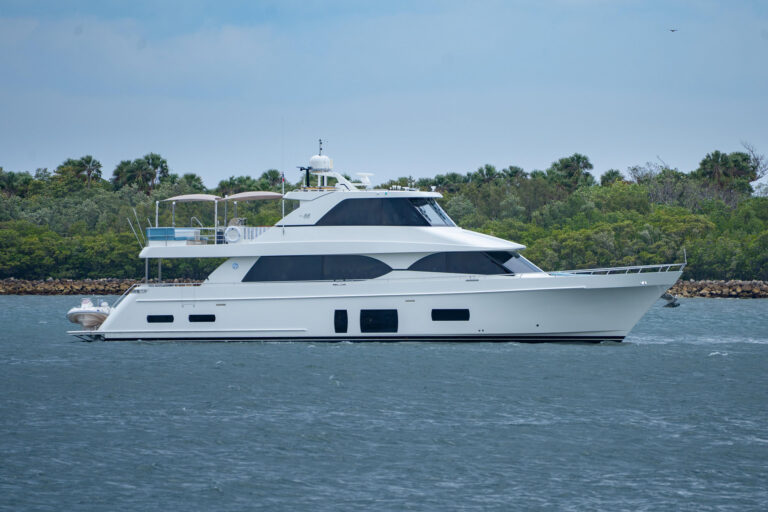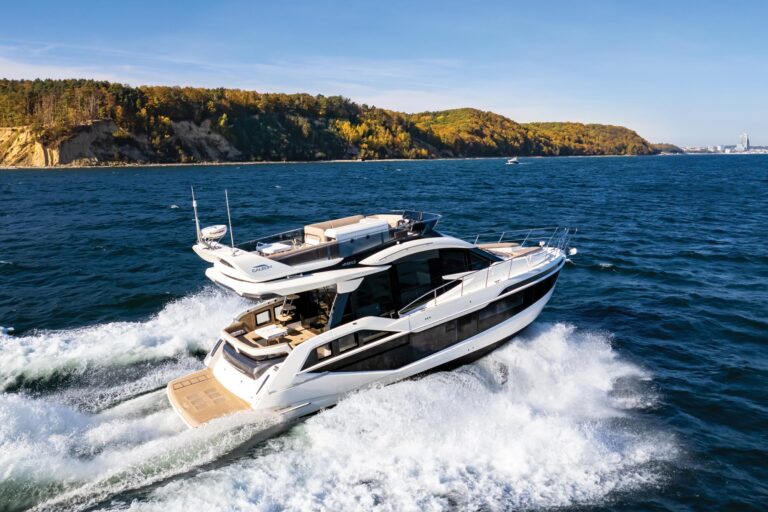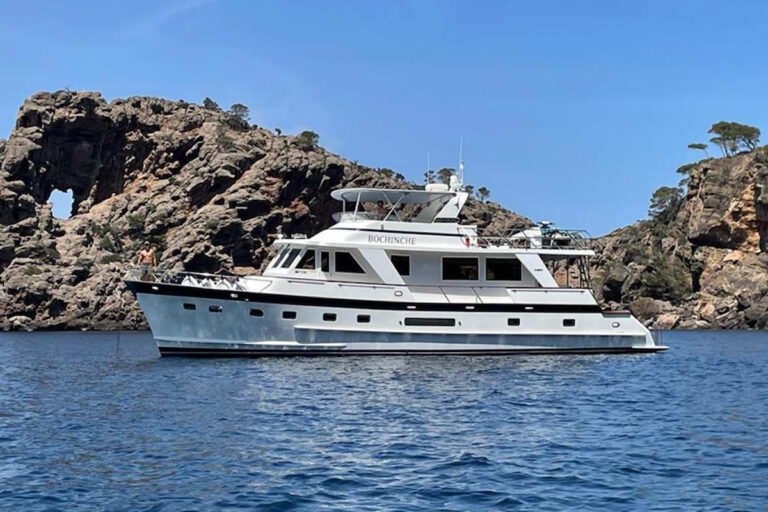Computer installations on yachts range from a single, standard off-the-shelf notebook to networked systems as elaborate as those installed in a modern office. The number of computers is generally in accordance with the size of the yacht, with one to five computer installations typical on vessels between 40 and well over 120 feet in length. However, systems employing as many as nine computers can be found on yachts less than 70 feet in length, courtesy of custom marine electronic firms that are able to satisfy even extreme appetites for computing power.
Many boat owners begin with a notebook computer running a chart plotting program, typically used to back up the dedicated chart plotter. In this role the computer provides additional navigation and record-keeping functions and permits voyage planning without interfering with real-time navigation. The computer may be operated as a stand-alone device or networked with a plotter as an integral part of the primary navigation system. Depending on the environment to which the computer may be exposed, one of the “hardened notebook computers may be desirable. A number of choices are available, including such units as the Dolch NotePAC or RuggedNote, the Broadax Systems water and dustproof, sunlight-readable screen W130, the GETAC M220, or the Panasonic Toughbook 18 or 29 notebook computers.
On many yachts the next upward step is a desktop computer driving a permanently mounted display adjacent to the main chart plotter. These computers are carefully isolated from any connection to an external network to prevent contamination of the operating programs. They are usually “locked down to preclude the local insertion of programs or alteration of operating instructions that might compromise the navigation function. Screen sizes used on the bridge range from 8 to 23 inches, with brightness levels ranging from the 200 Nit level needed for visibility in the controlled lighting environment of a pilothouse to 600 Nits in a daylight-viewable screen and 1200 Nits for full, direct-sunlight visibility. A typical installation might include a BigBay Mini PC package driving a 15-inch indoor, high-bright display, equipped with its own 12-volt DC-input power inverter.
Successful installations employ “hardened or “marinized computers and display screens purposely designed to withstand the rigors of the marine environment. Special conformal coatings are applied to circuit boards to increase protection from airborne contaminants. Circuit boards and other components are more effectively secured than is common in consumer-grade equipment. Special attention is devoted to shock and vibration isolation of hard-disk drives. Because excessive heat is the single greatest cause of electronic equipment failure, professional installations include additional cooling. Power supply integrity is a prime concern and requires special attention. AC current-powered installations include always-on uninterruptible power supplies. DC-powered systems are powered from a dedicated electronics bus that is supported by an isolated battery and carefully isolated from the ship’s power and engine-start circuits.
If you are skeptical about the need to bring a computer on board, consider the many advantages. Computer-driven displays of water temperature, forecast and current weather information are increasingly valuable to cruisers and fishermen alike. Data sources include various subscription services and information from the Internet. In most installations these displays can also show images of the engine room and cockpit from low light and infrared surveillance cameras connected to the yacht’s closed-circuit TV system.
In some installations computers running special software control the yacht’s communication system. The control computer automatically selects the optimum communication channel, choosing between satellite, high-frequency radio, Wi-Fi, cell phone and, where available, a land line connection.
The computer’s role in a yacht’s surveillance monitoring and information system is to continually record vessel movement, equipment and system status; it can, if desired, store a video and audio record from selected cameras. These systems are often designed to allow remote monitoring via satellite or, when the vessel is in port, over a wired or wireless Internet connection. Data collected by the engine and generator control and monitor systems can be integrated with the surveillance information to provide a complete timeline record of vessel operation.
Unlike the computers used in many business and industrial applications, the ones used in yacht systems do not have to be particularly powerful. Many of the standard software packages run quite happily on the Windows 2000 operating system; in fact, the marine electronic system designers tend to avoid using the newest operating systems in favor of those that have been thoroughly tested and debugged over time.
Whether you want an onboard computer for navigation, systems integration or ship’s management, research the players thoroughly, consider what you want to accomplish, and talk with your marine electronics expert before settling on new hardware.
| Contacts: Autonav Marine Systems Inc. Ruggedized PC computers and custom PCs, daylight and sunlight readable LCDs, including waterproof sunlight readable units. autoav.comBig Bay Technologies Inc. Ruggedized laptop, tower and mini PC computers for the marine environment. bigbaytech.comBroadax Systems Inc. Ruggedized laptop computers including units with sunlight readable LCD screens. www.bsicomputer.comDolch Inc. Ruggedized portable computers and LCD displays. dolch.comGetac Inc. Ruggedized laptop computers and wireless tablet PCs. getac.comNauticomp Inc. Custom displays and marinized computers, including a 12-volt DC CPU. nauticomp.comPanasonic Inc. Ruggedized laptop computers and wireless tablet PCs. www.panasonic.com/toughbookValhalla Enterprises Inc. (VEI) Manufacturers of marinized tower-type PCs, rack-mount marinized PCs, and SeaPC, an environmentally isolated ruggedized and marinized PC. vei-systems.com |

